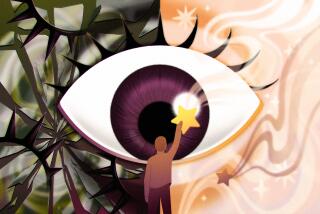The Fear Factor : Despite a declining death rate, Americans seem to be preoccupied with lurking dangers. It’s probably just that our perception of harm is skewed.
When Texas author and fisherman Wyatt Moore was 85, he arose every day, rain or shine, frosty or sultry, climbed into his rowboat, and spent the day rowing and fishing in Caddo Lake.
Posed with the question, “Since you’re retired, why don’t you just spend your days resting at home?” Moore replied: “I was born in 1901. The people I saw die, died at home in bed. The reason I grew to be 85, when other people died, is that I stayed out of bed and away from home.”
In Wyatt Moore’s youth, people indeed died at home, in bed. Hospitals were relatively few, and nursing homes for the elderly nearly nonexistent.
Today, we see people die on the nightly news, in plane crashes, in earthquakes, in drive-by shootings.
As a result, we bite our fingernails on airline flights, spend millions on alarms and guns for protection against murderous strangers, and worry about the mad bombers lurking on the fringes of our ordered, safe lives, waiting to blow our sense of security into unrecognizable shreds.
In reality, however, our perceptions of the greatest risks to our lives are often skewed.
Flying is still safer than driving. If someone is shot to death, it is more likely to be at the hands of a relative, friend or acquaintance. And, despite the deaths in the Oklahoma City and World Trade Center bombings, the likelihood of dying in a bomb blast in the United States is still less than that of being hit by lightning.
In 1994, the last year for which such numbers are available, 2,286,000 people died in the United States, according to the Centers for Disease Control and Prevention. Relative to the total population, this was the lowest death rate ever recorded.
Nevertheless, the American public has become more--rather than less--concerned about risk. In fact, we live in an atmosphere pervaded by fear, our lives corralled and governed by fear. Fear of strangers. Fear of taking a walk at night. Fear of the country. Fear of the city. Fear of passing cars. Fear of tailing cars. Fear of strange viruses. Fear of apples. Fear of Tylenol. Fear of aspirin. Fear of raw eggs. Fear of nuclear reactors. Fear of electrical high-tension wires. Fear of immigrants.
“People live a life from which death is almost completely excluded, except for quick hits on television, radio and the newspapers,” says noted pharmaco-epidemiologist Dr. John Urquhart. “By putting death offstage as we do, it leaves a few specific deaths heightened, creating the impression that people live in risky times.”
*
How is it that our perceptions of death diverge so far from reality?
Part of the answer lies in the difference in personal experience between those who grew up early in this century and the inhabitants of today’s modern high-tech world.
Before 1940, death was a greater part of people’s everyday lives, not just because people died at home, but because more people died at a younger age, usually from infectious disease.
Twenty percent of the people born in 1907 were dead by their 15th birthday, victims of childhood diseases such as measles, diphtheria, scarlet fever and whooping cough. The two leading causes of death among the general population were pneumonia and tuberculosis.
And half of the people born the same year as Wyatt Moore were dead more than 20 years ago, at the age of 67. But of today’s 20-year-olds, half won’t be dead until 2050, when they’re 75.
While it still holds true that most people die in bed, they die in institutional beds in nursing homes, boarding care homes or hospitals--out of public sight.
“In 1890, there was a painting called ‘The Doctor,’ ” says Urquhart, co-author of “Risk Watch: The Odds of Life,” (Facts on File, 1985), one of the first books to address risk analysis.
“It shows a little girl dying in bed, a doctor standing over her with a little bit of medicine in a glass and the parents standing in the background, hugging each other and crying. It was representative of death, because so many children died.
“A comparable painting today would be an 80-year-old lady with no people in the background hugging each other and crying. The doctor would be wearing green pajamas, and the lady would be surrounded by three nurses and equipment.”
*
Modern-day death has also resulted in a change in how we act. People’s behavior is being driven by their perceptions of risk, says Paul Slovic, a research psychologist with Decision Research, a nonprofit research institute in Eugene, Ore., and one of the few organizations that specializes in studies of decision-making and risk analysis.
“If their perceptions are faulty,” Slovic says, “efforts at personal protection are likely to be misdirected.”
Such as white women buying guns at an unprecedented rate to protect themselves from strangers, when, if they are attacked or killed, it is likely to be by a spouse or acquaintance.
Such as parents and teachers instilling into the minds of children the fear of strangers who kidnap or molest, when, if children are kidnapped or molested, it is more likely to be at the hands of a parent, a relative or friend.
In his book, Urquhart suggests devising a measure similar to the Richter scale to put the risk of the different types of deaths and injuries in perspective.
“With the Richter scale, which assigns a number to the intensity of an earthquake, people can tell the big ones from the little ones, even though they are not engineers. They know what level to get excited about and call their aunt in Los Angeles to see if the house fell down.”
He suggests that each newspaper, radio and television station hire a staff epidemiologist to assign a “safety-degree” number between 1 and 8 to the type of death or injury reported. The lower the safety-degree number, Urquhart says, the higher the risk. For example, lung cancer has a safety-degree status of 2.8, while death by bee sting hovers at 6.7.
*
But facts and statistics alone are not likely to change people’s minds, Slovic says, because people don’t make decisions based on expected annual mortality, as risk experts do.
“Research demonstrates that, whereas experts define risk in a narrow, technical way,” Slovic says, “the public has a richer, more complex view that incorporates value-laden considerations such as equity, catastrophic potential and controllability.”
For example, U.S. nuclear power plants have never killed anyone, but the public has put them in a category that Slovic terms “dread” risk--a perceived high risk for which people want to see stringent policing.
Slovic cites the accident at Three Mile Island in 1979. Not one person was killed, and few, if any, latent cancer fatalities are expected. Still, the costs that followed were astronomical. Society as well as the nuclear industry paid dearly in terms of stricter regulation, reduced operation of reactors worldwide, more opposition to nuclear power and reliance on more expensive energy sources.
“An accident that takes many lives may produce relatively little social disturbance beyond that caused the victims’ families and friends if it occurs as part of a familiar and well understood system, such as a train wreck,” Slovic explains.
“However, a small accident in an unfamiliar system--or one perceived as poorly understood such as a nuclear reactor or a recombinant DNA laboratory--may have immense social consequences if it is perceived as a harbinger of further, and possibly catastrophic mishaps.”
Just hearing about scientific studies on the health effects of electromagnetic fields, even though the research has revealed no reliable adverse results, will lead people to consider power lines and electric blankets as more dangerous.
A 1994 study by Slovic and colleagues Donald MacGregor and Granger Morgan showed that reading a brochure designed to inform people about the research being conducted on electromagnetic fields significantly increased people’s concerns about these risks, even though the brochure was not alarmist.
*
Other research shows that perceptions of risk change over time.
In 1979, Slovic asked University of Oregon students to rate the risks and benefits of several items. Nine years later, he asked a similar group to rate the same items.
“Across the eight-year period, there was remarkable stability for some items such as nonnuclear electric power, bicycles,” he says. “Some items showed sizable increases in perceived benefits--commercial aviation, heart surgery.
“By far the greatest change in perception occurred with marijuana, whose perceived benefit decreased from a mean of 53.3 [on a 100-point scale] to 21.2, and whose perceived risk increased from 25.4 to 41.0.”
Reducing perceived risk in this country will be a tough row to hoe, Slovic says. Part of the reason lies with scientists, who leave the interpretation of their results to media that are generally uneducated in what those results actually mean.
Another part of the problem lies in the fact that there’s almost no effort by risk analysts to learn how to use the risk information that’s being produced, Slovic says.
“I would say that there’s 10,000 times more effort going into the technical side--engineers and scientists studying the risks of chemicals, drugs, materials and structures--than is going into thinking about how to manage the information generated by these studies,” he says.
As a result, when public policy decisions must be made on how or whether to protect a community from a perceived risk--whether it be a bomber, a chemical plant or a violent gang--it’s not unusual that the perception of the public does not match that of risk experts.
But the public should not be ignored, Slovic says.
“The issue is not whether these are legitimate, rational considerations, but how to integrate public concerns and wisdom into risk analyses and policy decisions, along with the wisdom gleaned from scientific studies.”
Although risk experts are still trying to understand how to do this, one way, suggests Slovic, is to bring the general public to the table.
“Get their input early, take it seriously, share the power, make it so that people have a certain level of control.”
*
In this can-do American culture, many people think that since we’ve conquered everything else, why not death?
Sorry. Not possible. We all die, sooner or later.
Everyone who was born in 1690 was dead by 1820, as all people born in 1950 will be dead by 2080.
Wyatt Moore was born in 1901 and was dead by 1993. In bed, in a nursing home at the age of 92.
It’s a fact of life. The death rate, when all is said and done, is one per capita.
(BEGIN TEXT OF INFOBOX / INFOGRAPHIC)
What Kills Us
Cause and Rate per 100,000
1. Heart disease: 281.6
2. Cancer: 206.0
3. Stroke: 59.2
4. Lung disease: 39.1
5. Accidental deaths*: 34.6
6. Pneumonia and flu: 31.5
7. Diabetes: 21.2
8. Infections from HIV: 16.1
9. Suicide: 12.4
10. Chronic liver disease and cirrhosis: 9.9
11. Homicide: 9.7
* Accidental deaths include car accidents, at 16.2 per 100,000, and all other accidents, including drowning, falls, bicycle accidents and airplane crashes (18.4).
More to Read
Sign up for Essential California
The most important California stories and recommendations in your inbox every morning.
You may occasionally receive promotional content from the Los Angeles Times.










